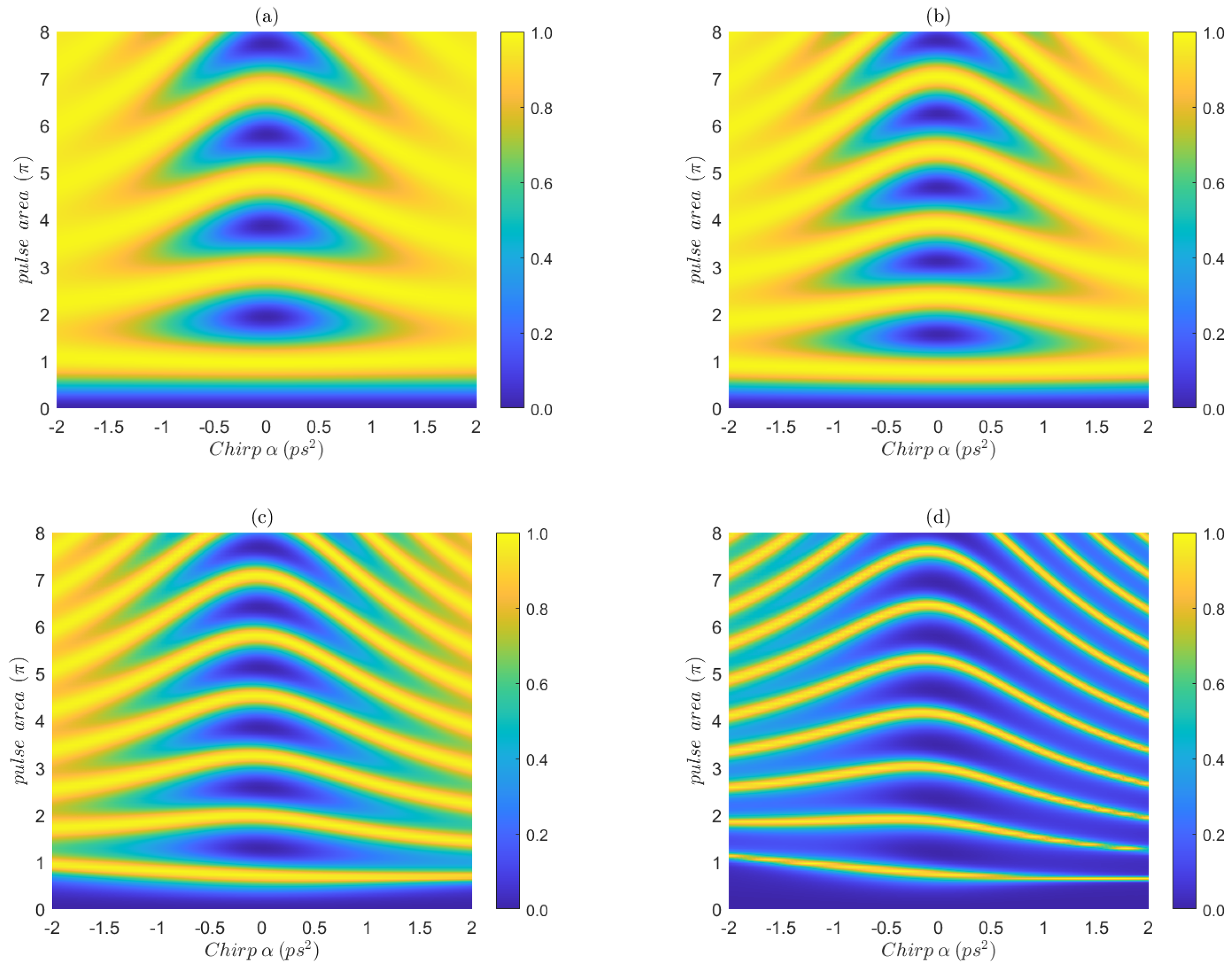Efficient Excitonic Population Transfer in a Coupled Quantum Dot–Metal Nanoparticle Structure Interacting with a Chirped Laser Pulse †
Abstract
:1. Introduction
2. Methods and Materials
3. Results and Discussion
4. Conclusions
Author Contributions
Funding
Conflicts of Interest
References
- Szychowski, B.; Pelton, M.; Daniel, M.C. Preparation and properties of plasmonic-excitonic nanoparticle assemblies. Nanophotonic 2019, 8, 517–547. [Google Scholar]
- Sadeghi, S.M. The inhibition of optical excitations and enhancement of Rabi flopping in hybrid quantum dot-metallic nanoparticle systems. Nanotechnology 2009, 20, 225401. [Google Scholar]
- Sadeghi, S.M. Tunable nanoswitches based on nanoparticle meta-molecules. Nanotechnology 2010, 21, 355501. [Google Scholar]
- Antón, M.A.; Carreño, F.; Melle, S.; Calderón, O.G.; Cabrera-Granado, E.; Cox, J.; Singh, M.R. Plasmonic effects in excitonic population transfer in a driven semiconductor-metal nanoparticle hybrid system. Phys. Rev. B 2012, 86, 155305. [Google Scholar]
- Paspalakis, E.; Evangelou, S.; Terzis, A.F. Control of excitonic population inversion in a coupled semiconductor quantum dot–metal nanoparticle system. Phys. Rev. B 2013, 87, 235302. [Google Scholar]
- Yang, W.X.; Chen, A.X.; Huang, Z.; Lee, R.K. Ultrafast optical switching in quantum dot-metallic nanoparticle hybrid systems. Opt. Express 2015, 23, 13032. [Google Scholar]
- McMillan, R.J.; Stella, L.; Grüning, M. Projected equations of motion approach to hybrid quantum/classical dynamics in dielectric-metal composites. Phys. Rev. B 2016, 94, 125312. [Google Scholar]
- Qi, Y.; Shu, C.-C.; Dong, D.-Y.; Petersen, I.R.; Jacobs, K.; Gong, S.-Q. Fast quantum state transfer in hybrid quantum dot-metal nanoparticle systems by shaping ultrafast laser pulses. J. Phys. D: Appl. Phys. 2019, 52, 425101. [Google Scholar]
- Malinovsky, V.S.; Krause, J.L. General theory of population transfer by adiabatic rapid passage with intense, chirped laser pulses. Eur. Phys. J. D 2001, 14, 147–155. [Google Scholar]
- Lüker, S.; Gawarecki, K.; Reiter, D.E.; Grodecka-Grad, A.; Axt, V.M.; Machnikowski, P.; Kuhn, T. Influence of acoustic phonons on the optical control of quantum dots driven by adiabatic rapid passage. Phys. Rev. B 2012, 85, 121302. [Google Scholar]
- Simon, C.M.; Belhadj, T.; Chatel, B.; Amand, T.; Renucci, P.; Lemaître, A.; Krebs, O.; Dalgarno, P.A.; Warburton, R.J.; Marie, X.; et al. Robust quantum dot exciton generation via adiabatic passage with frequency-swept optical pulses. Phys. Rev. Lett. 2011, 106, 166801. [Google Scholar]
- Wei, Y.J.; He, Y.M.; Chen, M.C.; Hu, Y.N.; He, Y.; Wu, D.; Schneider, C.; Kamp, M.; Hofling, S.; Lu, C.Y.; et al. , Deterministic and robust generation of single photons from a single quantum dot with 99.5% indistinguishability using adiabatic rapid passage. Nano Lett. 2014, 14, 6515–6519. [Google Scholar]

Publisher’s Note: MDPI stays neutral with regard to jurisdictional claims in published maps and institutional affiliations. |
© 2020 by the authors. Licensee MDPI, Basel, Switzerland. This article is an open access article distributed under the terms and conditions of the Creative Commons Attribution (CC BY) license (https://creativecommons.org/licenses/by/4.0/).
Share and Cite
Smponias, A.; Stefanatos, D.; Paspalakis, E. Efficient Excitonic Population Transfer in a Coupled Quantum Dot–Metal Nanoparticle Structure Interacting with a Chirped Laser Pulse. Mater. Proc. 2021, 4, 91. https://doi.org/10.3390/IOCN2020-07884
Smponias A, Stefanatos D, Paspalakis E. Efficient Excitonic Population Transfer in a Coupled Quantum Dot–Metal Nanoparticle Structure Interacting with a Chirped Laser Pulse. Materials Proceedings. 2021; 4(1):91. https://doi.org/10.3390/IOCN2020-07884
Chicago/Turabian StyleSmponias, Athanasios, Dionisis Stefanatos, and Emmanuel Paspalakis. 2021. "Efficient Excitonic Population Transfer in a Coupled Quantum Dot–Metal Nanoparticle Structure Interacting with a Chirped Laser Pulse" Materials Proceedings 4, no. 1: 91. https://doi.org/10.3390/IOCN2020-07884
APA StyleSmponias, A., Stefanatos, D., & Paspalakis, E. (2021). Efficient Excitonic Population Transfer in a Coupled Quantum Dot–Metal Nanoparticle Structure Interacting with a Chirped Laser Pulse. Materials Proceedings, 4(1), 91. https://doi.org/10.3390/IOCN2020-07884






